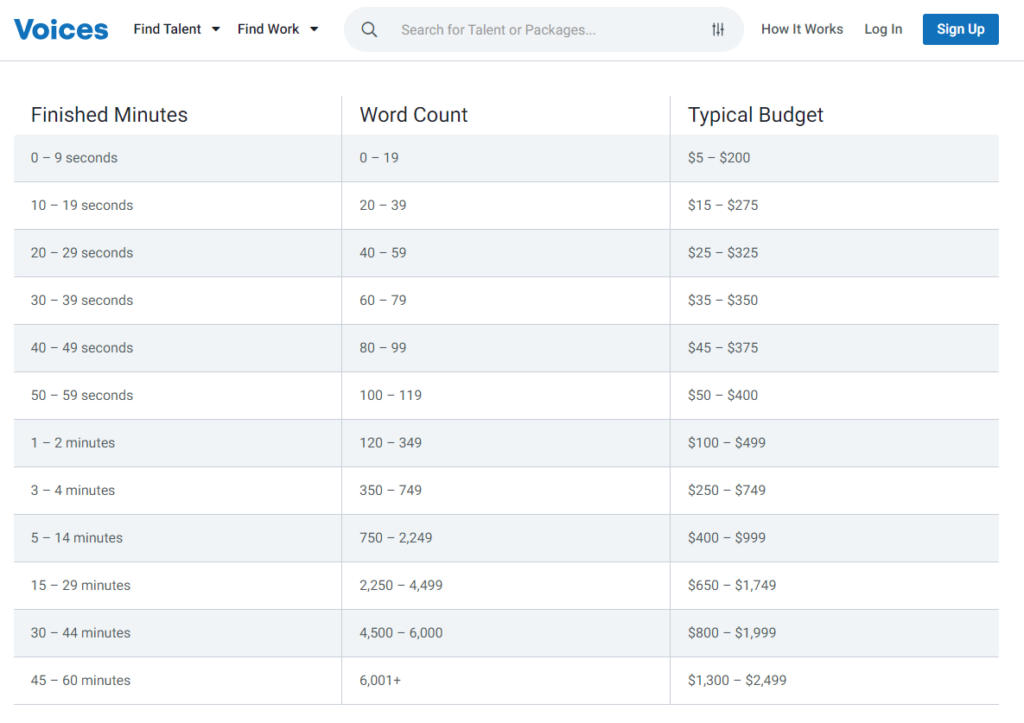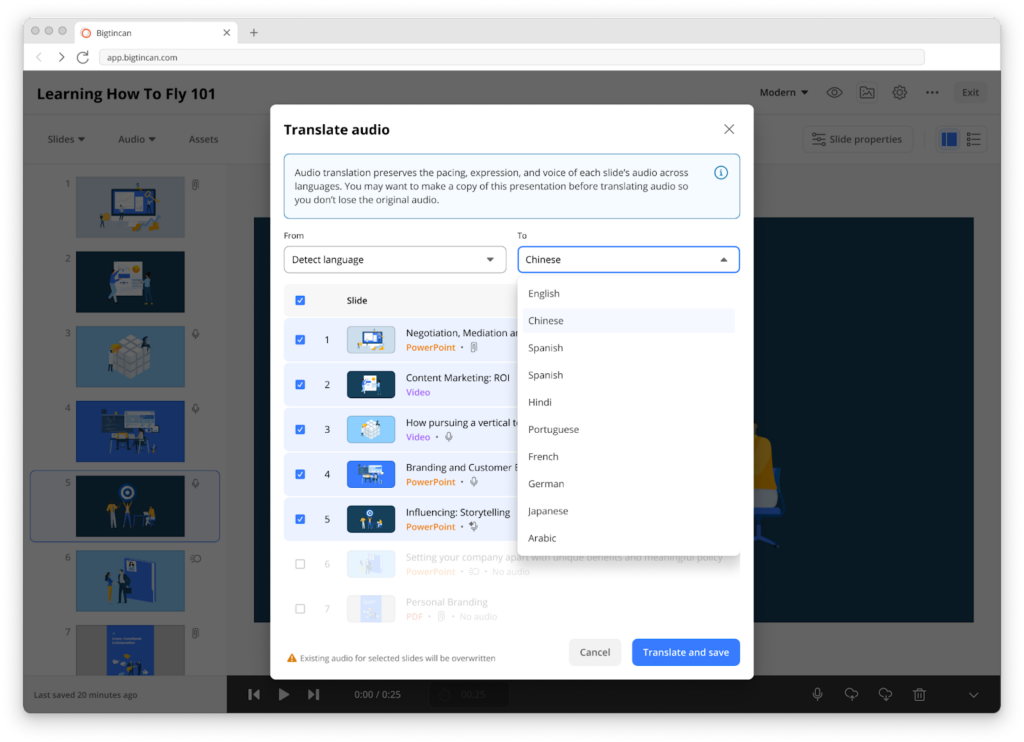Whether you have an enablement team of two attempting to serve hundreds of employees or a team of 10 instructional designers dealing with too much red tape, inefficiencies in your learning authoring process are costing you.
Slow, inconsistent, and ineffective training causes a slew of costly problems for corporations:
- Loss of employee productivity and engagement
- Decreased employee and customer satisfaction
- Increased employee and customer churn
- Business expenses from unsafe work environments, employee errors, and resulting legal issues
Here’s a look at how much common inefficiencies are costing you both qualitatively and quantitatively.
Common inefficiencies in the learning authoring process
1. Sourcing and production timelines for voice over recordings
The process for sourcing voice-over talent involves careful planning, clear communication, and attention to detail to ensure that the final product meets expectations and deadlines.
It can take anywhere from a few days to a couple of weeks to find the right voice-over artist, brief them on the project, receive and review multiple drafts, and land on the final product.
The typical process for a voice-over project involves several key steps:
- Writing the script.
- Ensuring audio-visual synchronization. If the voice-over project corresponds to a video, it’s important to confirm whether the audio needs to be synchronized with the video. This process is referred to as timed vs untimed voice-over and will play a factor in how the script reader paces themselves while speaking.
- Browsing voice-over marketplaces like Voices, Fiverr, and Voice123 to find the right fit for your project..
- Getting and reviewing samples. Requesting samples of the voice-over talent’s work will help gauge whether they are the best fit for the project.
- Giving and clarifying instructions. Clearly communicating expectations to the voice-over talent is essential for an effective project. You need to share details such as preferred pronunciation for acronyms and special terms, whether numbers on a list should be read, and if special emphasis is needed should be clearly communicated.
- Waiting for deliverables. It’s important to consider the turnaround time for voice-over work, which can vary based on the size of the project and how hands-on you’d like to be in the process.
- Reviewing recordings, giving feedback, and waiting for the final draft.
- Attaching the approved audio to your learning content and launching it to your team.
If you decide to forgo this process and source voice-over talent in-house (or just do it yourself), recording your own audio also takes time.
Since you aren’t using a professional voice-over artist in this case, whoever is doing the narration — likely your in-house trainers or subject matter experts — will require even more preparation and takes to nail the performance.
Associated costs
Time
While good voice-over is a huge quality add, if you have a small learning and development or enablement team in charge of sourcing, working with, or even acting as voice contributors, that eats into their limited time. Especially if they are expected to produce a high volume of high quality work.
Then there’s the matter of waiting for deliverables from the artist (if you choose to use one), reviewing their work, requesting changes, and getting to the final product.
Budget
For voice-over and dubbing services, the cost can start from $100 per minute or even more. [data: Ampere Translations]
On this pricing breakdown from Voices, you can see that voice over for a 5-14-minute training video ranges in cost from 400 to 999 dollars. If your training team has a small budget (like so many do these days), they will likely be limited on how often they outsource voice over.

2. Keeping learning content fresh and consistent
As training content becomes outdated or requires revisions, organizations are faced with the daunting task of updating huge repositories of old presentations and videos.
But the time spent keeping learning content fresh is a necessary evil. The alternative — not updating — costs even more. Outdated, disorganized training content can lead to overwhelm, confusion, a lack of interest, and disengagement from employees, which of course results in an adoption problem.
Updating training content often involves rerecording voice-over as new slides are added, a time-consuming endeavor that disrupts workflow and drains resources.
Furthermore, the inability to locate scripts or slide notes for older presentations exacerbates the challenges, leading to inconsistencies in content and hindering effective knowledge transfer.
Associated costs
Updating voice over either by sourcing talent or rerecording in-house and making sure new audio syncs up with visuals requires a near-constant time investment on the part of your learning authors as well as budget if voice-over is outsourced.
But leaving content to rot risks more expensive qualitative and quantitative costs:
- Disengaged employees cost companies roughly $3,400 for every $10,000 in salary, ultimately costing the American economy $350 billion annually. [data: McLean & Company]
- Without a strategy for reinforcing new skills after the training ends, knowledge decay sets in very quickly, resulting in lost investment in training programs. Nearly 90% of new skills are lost and forgotten within a year [data: Training Industry]
- Employees who don’t receive proper onboarding and professional development from their employers tend to be disengaged and present a higher churn risk. A study by the Society for Human Resources Management (SHRM) found the average cost of losing an employee is six months of their base salary. So if your average employee salary is $80,000, the average cost of losing an employee would be $40,000.
3. Making sure all learning materials are accessible and compliant
Ensuring accessibility in training content is not just a moral imperative but also a legal requirement.
Video captioning, in particular, plays a crucial role in facilitating accessibility for individuals with hearing impairments.
Moreover, inaccessible training content hampers employee engagement and comprehension, leading to suboptimal learning outcomes and decreased productivity.
Associated costs
- Non-compliance with ADA guidelines can result in costly lawsuits, settlements, and fines. Federal law allows fines of up to $75,000 for the first violation and $150,000 for additional ADA violations. States and local governments may allow additional fines and require businesses to meet a higher standard of accessibility than the ADA requires
- Damage to your business’s reputation. Non-compliance with ADA standards may result in negative reviews, social media backlash, and a loss of customer trust.
- Employee morale and productivity. ADA compliance extends beyond physical accessibility — it also includes ensuring equal employment opportunities for individuals with disabilities. Non-compliance can impact employee morale, productivity, and loyalty.
- If any employees are missing information due to lack of access to proper training, especially in high-risk industries like life sciences or manufacturing, there is a higher chance of costly errors.
4. Translating training content for diverse and distributed workforces
With so many multinational, remote-first, and distributed companies, the need for multilingual training content is more pronounced than ever. However, the reliance on traditional translation services poses significant challenges in terms of cost and timeliness.
Delays in distributing translated materials to global workforce segments impede the uniform dissemination of vital information, leading to inconsistencies in messaging and approaches across teams.
Associated costs
- The average industry estimates for translating video content range from $150 to $250 for a 5-minute audio recording. [data: marstranslation]
- Additionally, the translation of subtitles is calculated per minute and varies depending on the language and other factors, with rates ranging from $4-$9 per minute. [data: Ampere Translations]
- Time spent sourcing and waiting for deliverables from translation service providers.
But, much like accessible and updated content, the cost of not translating training materials is even higher.
The cost of uneven, inconsistent training throughout your workforce is seen in employee and customer satisfaction ratings, as well as net new revenue losses.

You can’t invest in training for one team and neglect others. It impacts the morale, opportunities, and longevity of those employees who aren’t receiving the same level of training.
Plus, you can lose both existing and new customers due to varying levels of knowledge and skill among employees. Imagine your customers hearing different pricing or product information depending on where they are or which rep they speak to!!
That negative experience will lose that customer as well as those who hear about it via word of mouth.
Turning losses into wins
These inefficiencies in the learning authoring process can have a substantial impact on your company’s bottom line, but neglecting your training programs and those responsible for them will likely cost you even more in the long run.
So where does this leave you?
By understanding the real statistics behind the costs of poor employee training, businesses can make informed decisions to optimize their learning content development processes and drive better outcomes for both employees and the company as a whole.
These numbers remind us of the old refrain “time is money” and just how valuable it is to deliver effective training in a timely manner.
They’re also a reminder that smart investments in the right areas turn losses into long-term gains.
Learn how you can enable global team readiness for greater revenue impact with AuthoringAI using its speech-to-text, text-to-speech, and translation features that fill in these efficiency gaps and help your learning authors meet their ambitious goals.

Pictured: Brainshark AuthoringAI
A breakdown of what inefficient learning authoring processes cost your business in both qualitative and quantitative measures.
